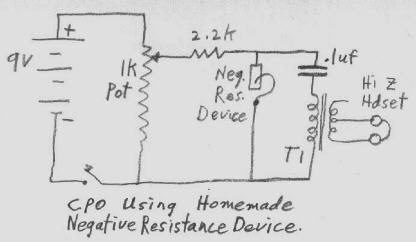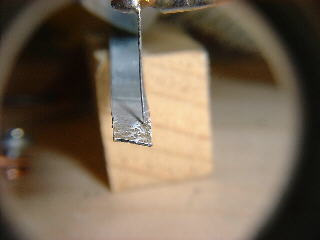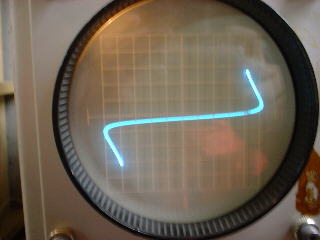


Listening for a tone through a pair of earphones makes it easy to experiment with negative resistance materials without having to use a radio or any test equipment such as an oscilloscope or curve tracer. The heat treated zinc material seems to be the king so far for ease of use but I was even able to get audio oscillations from a heat treated piece of steel "music" wire. The procedure is to hunt around with the catwhisker at different pot settings until a tone is heard in the phones. A high impedance earphone is best as it tends to put less of a load on the circuit and thus increases the chance of getting oscillation. A low impedance load will work however, in fact; an 8 ohm speaker worked well and put out a faint tone that could be heard across the room.
Actual sound of Negatave Resistance CPO using heat treated galvanized sheet metal. (84K .wav file):
This circuit can easily produce RF frequencies in the AM Broadcast band if an appropriate LC circuit is connected in place of the audio one. Not all catwhisker settings that produces oscillation at audio frequencies, however, will oscillate at Broadcast band frequencies when switching LC circuits. It must be that different catwhisker settings can produce different bandwith capabilities. Nevertheless, it is very exciting to hear the audio tone that ensures that the negative resistance material is operating. A key in series with the battery makes this circuit into a good code practice oscillator. It is best however, to have the key mounted away from the oscillator, preferably on your lap or another table as the catwhisker is vibration sensitive.
The negative resistance device was easily made by putting the end of a thin 1/4 inch wide strip of galvanized sheet metal, of the type used for furnace ducts, in the flame of a propane torch till it glowed bright red. It is a good idea to do this out of doors and to avoid breathing any of the smoke or fumes. People who are knowledgeable about welding say that poisonus fumes are produced when welding galvanized metal. After cooling, small dark spots would appear, especially on the side opposite where the flame struck. These dark spots are the main negative resistance areas. The catwhiskers tried were 28 gauge steel wire and 30 gauge copper wire. Both seemed to work well. The circuit (as with the iron pyrites) seems to be very forgiving as to the applied voltage level (pot setting).
As can be seen on the curve tracer, the curve can be quite symmetrical in both the negative and positive direction, although I sometimes would observe a more non symmetrical curve. It is also possible that applied dc could have some cumulative effect on the symmetry of the curve. This picture was taken while the curve tracer was applying ac to the device. I had to modify it so it could apply ac.
The oscillator circuit can be run easily from one 9v battery and it seems easier to obtain steady oscillation when the catwhisker is biased negative with respect to the metal strip. Some steady oscillation can be obtained however with the catwhisker positively biased.




Normal catwhiskers seemed difficult to adjust so I built what I call a "Tone Arm Catwhisker" because of its resemblance to a phonograph tone arm. The idea of the Tone Arm catwhisker is to make it light and easy to move up and down, but rigid in sideways motion. This makes the catwhisker able to rest on slanted or round surfaces without sliding off. The sliding off aspect does not seem as important though when used on the flat strip of heat treated galvanized sheet metal. The picture of the Tone Arm is self explanatory; a triangular wire frame, a weighted base (with three felt bumpers on the bottom) and hinges to allow the arm to move up and down easily. The coil on the base is thin 30 gauge copper wire to make electrical connection to the arm without interfering with its delicate movements.
It seems that anything associated with zinc can make a negative resistance device. Even the heat treated galvanized nail can produce oscillations with careful adjustment. A heat treated zinc chromate 6-32 nut seemed to work very well and was very easy to adjust. I was able to get oscillations with somewhat more difficulty, using a heat treated strip of thin brass.